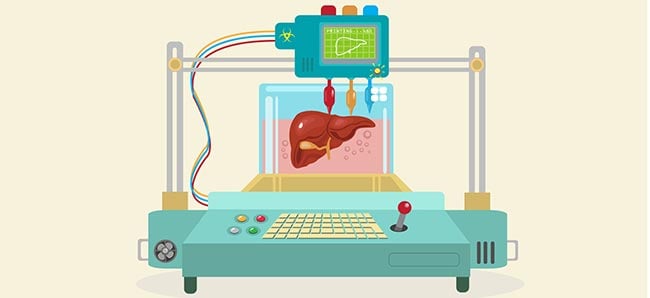
Aug 7, 2020
Blog Life Sciences Bioprinting: Market Trends You Need To Know
The modernization of technology has led to rapid advances in the printing domain. From paper printing using inkjet and laser technologies, there was the development of 3D printing by Charles Hull.
3D printing involves the use of digital instructions to manufacture specific shapes and forms using various materials such as plastics, metals, polymers and others. Innovations in technology and a drive to meet the demands for safe toxicity and drug testing methods as well as a shortage of organ donors resulted in the emergence of bioprinters or 3D-bioprinters.
In contrast to 3D printing, which uses nonliving materials for construction, bioprinters employ living cells to build tissues and organs.
How Bioprinting Works
In a typical bioprinting process, the first step is to create a model of the organ using biopsy samples, CT (computed tomography) scans and MRIs (magnetic resonance imaging). Generally, a computer-aided design (CAD) software is used for this purpose.
A bioink composed of a mixture of cell and growth factors is then added to the scaffold (confined 3D structures) in a layer-by-layer approach to generate tissue-like structures. The cells, biomaterials and biomolecules are precisely placed in spatially pre-defined locations within the scaffolds. The 3D printed cells and tissues are then nurtured in bioreactors that deliver mechanical and chemical signals to the cells within the printed tissues.
As part of this process, the printed tissue’s morphology and functionality must be tested. This is routinely carried out non-invasively using high-resolution fluorescence microscopy and histology methods.
Bioprinting and Organs
There is a huge unmet demand for organs. Bioprinting of 3D organs has the potential to reduce the endless wait lists of organ donations and revolutionize the medical industry.
For example, when treating a burn, autologous skin grafting is limited by space on the body—the larger the burn site, the less of the patient there is to harvest healthy skin from. But bioprinting gives physicians the ability to take a tiny sample of skin, replicate it with the correct bioinks and print as much as is needed.
Though a number of studies are going on catering to the development of fully, functional organs by bioprinting, several challenges remain.
These pertain to the fabrication of complex tissues with multiple cell types, the issue of resolution and the incorporation of vascularization, among other factors.
Bioprinting Trends and Projections
For additional intel into the global market for bioprinting (and an interview with Biogelx), download our white paper, The Future of Bioprinting: A BCC White Paper.

Sarah Greenberg is the Manager of Content Marketing at BCC Research. She creates our blog, social media and email content.
In today’s fast-paced biomedical world, researchers and pharmaceutical companies...

Radiopharmaceuticals represent a cutting-edge frontier in modern medicine, offer...

Implantable Remote Patient Monitoring (IRPM) devices are revolutionizing healthc...

We are your trusted research partner, providing actionable insights and custom consulting across life sciences, advanced materials, and technology. Allow BCC Research to nurture your smartest business decisions today, tomorrow, and beyond.
Contact UsBCC Research provides objective, unbiased measurement and assessment of market opportunities with detailed market research reports. Our experienced industry analysts assess growth opportunities, market sizing, technologies, applications, supply chains and companies with the singular goal of helping you make informed business decisions, free of noise and hype.